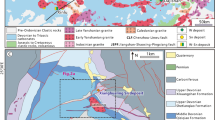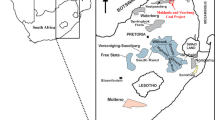Abstract
In this study, the chemical composition of calcite crystals and pore-filling sediments in a stalagmite from Küpeli Cave was investigated for the first time using the electron probe microanalysis (EPMA). It was supplemented by petrographic, X-ray diffraction (XRD), scanning electron microscopy (SEM), and energy-dispersive X-ray spectroscopy (EDX) analyses to improve understanding of EPMA findings. The EPMA results show that the stalagmite consists mainly of pure calcite crystals with a CaO composition of 56 ± 1 wt%. These crystals are the primary components of both sparite calcite mosaic and dendritic microfabrics. Calcite crystals in the dendritic microfabric appear as long fiber-like crystals surrounding calcite needles extending in two directions and cement filling the pores between these crystals. Internal sediments are also abundant in the pores of the dendritic microfabric and contain components such as Al2O3, SiO2, K2O, FeO, and CaO. The XRD analyses show that the pore-filling sediments consist mainly of calcite, smectite, quartz, chlorite, and feldspar. The abundance of siliceous constituents in the internal sediment, together with the stalagmite position within the conduit, indicate that the clastic sediments in the pores were deposited primarily by floods. However, it is thought that some clastic carbonates in the pores may have been transported by water dripping from the epikarst region.






Similar content being viewed by others
Data availability
The data presented in this article are available from the corresponding author.
References
Akgöz M (2012) Göksu nehri ve Lamas kanyonu (Mersin) arasında kalan bölgenin karst evrimi. Unpublished PhD Thesis, Mersin University
Akgöz M, Eren M (2015) Traces of earthquakes in the caves: Sakarlak Ponor and Kepez Cave, Mersin (S Turkey). J Caves Karst Stud 77:63–74. https://doi.org/10.4311/2013ES0120
Bar-Matthews M, Ayalon A, Kaufman A (1997) Late Quaternary palaeoclimate in the eastern Mediterranean region from stable isotope analysis of speleothems at Soreq Cave, Israel. Quat Res 47:155–168. https://doi.org/10.1006/qres.1997.1883
Belli R, Borsato A, Frisia S, Drysdale R, Maas R, Greig A (2017) Investigating the hydrological significance of stalagmite chemical (Mg, Sr) using Sr isotope and particulate element records across the Late Glacial-to-Holocene transition. Geochim Cosmochim Acta 197:247–263. https://doi.org/10.1016/j.gca.2016.10.024
Breitenbach SFM, Rehfeld K, Goswami B, Baldini JUL, Ridley HE, Kennett DJ, Prufer KM, Aquino VV, Asmerom Y, Polyak VJ, Cheng H, Kurths J, Marvan N (2012) Constructing proxy records from age models (COPRA). Clim PAst 8:1765–1779. https://doi.org/10.5194/cp-8-1765-2012
Dasgupta S, Saar MO, Edwards L, Shen CC, Cheng H, Alexander EC (2010) Three thousand years of extreme rainfall events recorded in stalagmites from Spring Valley Caverns, Minnesota. Earth Planet Sci Lett 300:46–54. https://doi.org/10.1016/j.epsl.2010.09.032
Denniston RF, Luetscher M (2017) Speleothems as high-resolution paleoflood archives. Quat Sci Rev 170:1–13. https://doi.org/10.1016/j.quascirev.2017.05.006
Eren M (2008) Olba (Ura-Uğuralanı) jeoarkeolojisi (Silifke, Mersin). In: Dönmez H, Özme A (eds) 24. Arkeometri Sonuçları Toplantısı, Kültür ve Turizm Bakanlığı Yayın No: 3173, Ankara, 26–30 Mayıs 2008, pp 181–192 (in Turkish)
Eren M, Kadir S, Kapur S, Huggett J, Zucca C (2015) Colour origin of Tortonian red mudstones within the Mersin area, southern Turkey. Sediment Geol 318:10–19. https://doi.org/10.1016/j.sedgeo.2014.12.003
Eren M, Akgöz M, Kadir S, Kapur S (2021) Primary characteristics of selected stalagmites from four caves located between Erdemli and Silifke (Mersin), southern Turkey—implications on their formation. Carbonates Evaporites 36:2. https://doi.org/10.1007/s13146-021-00684-y
Fairchild IJ, Baker A (2012) Speleothem science—from process to past environments. Wiley-Blackwell, Chichester
Fleitmann D, Cheng H, Badertscher S, Edwards RL, Mudelsee M, Göktürk OM, Fankhauser A, Pickering R, Raible CC, Matter A, Kramers J, Tüysüz O (2009) Timing and climatic impact of Greenland interstadials recorded in stalagmites from northern Turkey. Geophys Res Lett 36:L19707. https://doi.org/10.1029/2009GL040050
Frisia S, Borsato A (2010) Karst. In: Alonso-Zarza AM, Tanner LH (eds) Carbonates in continental settings. Elsevier, Amsterdam, pp 269–318
Gázquez F, Calaforra JM, Forti P, Stoll H, Ghaleb B, Delgado-Huerta A (2014) Paleoflood events recorded by speleothems in caves. Earth Surf Process Landf 39:1345–1353. https://doi.org/10.1002/esp.3543
Gedik A, Birgili Ş, Yılmaz H, Yoldaş R (1979) Mut-Ermenek-Silifke yöresinin jeolojisi ve petrol olanakları. TJK Bülteni 22:7–26 (in Turkish)
Göktürk OM, Fleitmann D, Badertscher S, Cheng H, Edwards RL, Fankhauser A, Tüysüz O, Kramers J (2011) Climate on the southern Black Sea coast during the Holocene: implications from the Sofular Cave record. Quat Sci Rev 30:2433–2445. https://doi.org/10.1016/j.quascirev.2011.05.007
González-Lemos S, Jiménez-Sánchez M, Stoll HM (2015) Sediment transport during recent cave flooding events and characterization of speleothem archives of past flooding. Geomorphology 228:87–100. https://doi.org/10.1016/j.geomorph.2014.08.029
Ji K, Zhu E, Chu G, Aquino-López MA, Hou J (2021) A record of late Holocene precipitation on the Central Tibetan Plateau inferred from varved lake sediments. J Paleolimnol 66:439–452. https://doi.org/10.1007/s10933-021-00215-8
Klaes B, Wörner G, Kremer K, Simon K, Kronz A, Scholz D, Mueller CW, Höschen C, Struck J, Arz HW, Thiele-Bruhn S, Schimpf D, Kilian R (2022) High-resolution stalagmite stratigraphy supports the Late Holocene tephrochronology of southernmost Patagonia. Commun Earth Environ 3:article id 23. https://doi.org/10.1038/s43247-022-00358-0
Kuczumo A, Genty D, Chevallier P, Nowak J, Florek M, Buczyn A (2005) X-ray and electron microprobe investigation of the. speleothems from Godarville tunnel. Xray Spectrom 34:502–508. https://doi.org/10.1002/xrs.877
Lascu I, Feinberg JM (2011) Speleothem magnetism. Quat Sci Rev 30:3306–3320. https://doi.org/10.1016/j.quascirev.2011.08.004
Onac BP, Forti P (2011) Minerogenetic mechanisms occurring in the cave environment: an overview. Int J Speleol 40:79–98. https://doi.org/10.5038/1827-806X.40.2.1
Özgül N (1983) Stratigraphy and tectonic evolution of the Central Taurides. In: Tekeli O, Göncüoğlu MC (eds) The international symposium on the geology of the Taurus Belt, mineral research and exploration. Institude-Geological Society of Turkey, Ankara, pp 77–90
Railsback BL, Brook GA, Webster JW (1999) Petrology and paleoenvironmental significance of detrital sand and silt in a stalagmite from Drotsky’s cave, Botswana. Phys Geogr 20:331–347. https://doi.org/10.1080/02723646.1999.10642682
Rowe PJ, Mason JE, Andrews JE, Marca AD, Thomas L, Calsteren PV, Jex CN, Vonhof HB, Al-Omari S (2012) Speleothem isotopic evidence of winter rainfall variability in northeast Turkey between 77 and 6 ka. Quat Sci Rev 45:60–72. https://doi.org/10.1016/j.quascirev.2012.04.013
Schimpf D, Kilian R, Kronz A, Simon K, Spötl C, Wörner G, Deininger M, Mangini A (2011) The significance of chemical, isotopic, and detrital components in three coeval stalagmites from the superhumid southernmost Andes (53°S) as high691 resolution palaeo-climate proxies. Quat Sci Rev 30:443–459. https://doi.org/10.1016/j.quascirev.2010.12.006
Tang G-Q, Li X-H, Li Q-L, Liu Y, Ling X-X (2020) A new Chinese national reference material (GBW04481) for calcite oxygen and carbon isotopic microanalysis. Surf Interface Anal 52:190–196. https://doi.org/10.1002/sia.6712
Turkish State Meteorological Service (DMI) (2020) Unpublished climatic data from 1980 to 2019, Erdemli/Mersin 17958 Station
Ünal-İmer E (2015) U-series geochronology and geochemistry of vein and cave carbonate deposits in Turkey: the relationship between late Quaternary tectonic and climatic events. Unpublished PhD Thesis, University of Queensland
Ünal-İmer E, Shulmeister J, Zhao J, Uysal IT, Feng Y, Nguyen AD, Yüce G (2015) An 80 kyr-long continuous speleothem record from Dim Cave, SW Turkey with paleoclimatic implications for the Eastern Mediterranean. Sci Rep 5:13560. https://doi.org/10.1038/srep13560
Ünal-İmer E, Shulmeister J, Zhao J, Uysal IT, Feng Y (2016) High-resolution trace element and stable/radiogenic isotope profiles of late Pleistocene to Holocene speleothems from Dim Cave, SW Turkey. Palaeogeogr Palaeoclimatol Palaeoecol 452:68–79. https://doi.org/10.1016/j.palaeo.2016.04.015
Wang B, Harder TH, Kelly ST, Piens DS, China S, Kovarik L, Keiluweit M, Arey BW, Gilles MK, Laskin A (2016) Airborne soil organic particles generated by precipitation. Nat Geosci 9:433–437. https://doi.org/10.1038/ngeo2705
White WB (1988) Geomorphology and hydrology of Karst Terrains. Oxford University Press, Oxford
Zupančič N, Miler M, Šebela S, Jarc S (2016) Application of scanning electron microscopy/energy-dispersive X-ray spectroscopy for characterization of detrital minerals in karst cave speleothems. Microsc Microanal 22:87–98. https://doi.org/10.1017/S1431927615015688
Acknowledgements
The authors are grateful to the anonymous reviewers for their constructive reviews that improved the quality of the paper significantly.
Author information
Authors and Affiliations
Contributions
The article was written under the supervision of the second author (ME), from a section of the first author (MP)'s Master's thesis. The third author (SK) contributed to some analyses.
Corresponding author
Ethics declarations
Conflict of interest
The authors declare that they have no competing interest.
Additional information
Publisher's Note
Springer Nature remains neutral with regard to jurisdictional claims in published maps and institutional affiliations.
Rights and permissions
Springer Nature or its licensor (e.g. a society or other partner) holds exclusive rights to this article under a publishing agreement with the author(s) or other rightsholder(s); author self-archiving of the accepted manuscript version of this article is solely governed by the terms of such publishing agreement and applicable law.
About this article
Cite this article
Palvanov, M., Eren, M. & Kadir, S. EPMA analysis of a stalagmite from Küpeli Cave, southern Turkey: implications on detrital sediments. Carbonates Evaporites 39, 3 (2024). https://doi.org/10.1007/s13146-023-00915-4
Accepted:
Published:
DOI: https://doi.org/10.1007/s13146-023-00915-4




